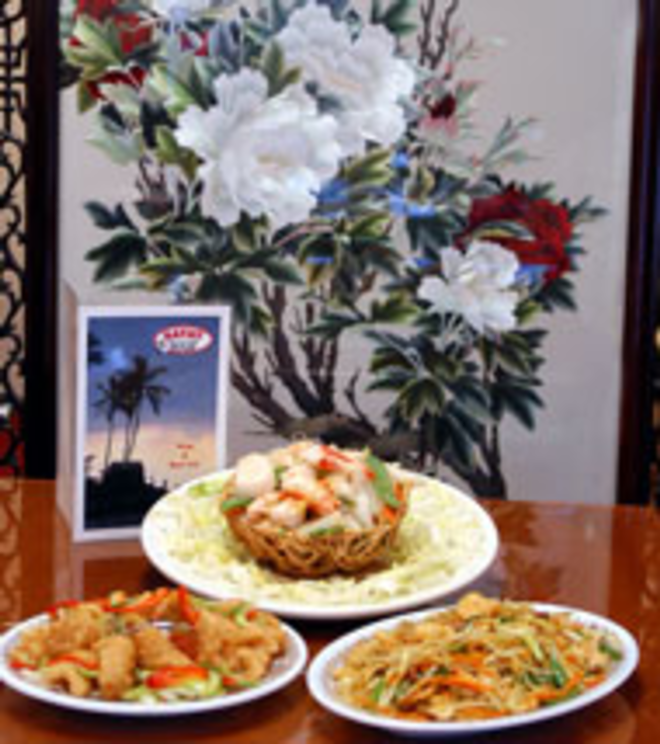
"Malaysians are obsessed with food." That is what Joohooi, a Malaysian friend of mine, remarked by way of accounting for the obvious pleasure she got from a dish of Satay House's "roti canai" (Indian pancakes).
Consider me Malaysian. I was, if not obsessed, altogether taken with Satay House's amazing pickled vegetable salad. Ditto the ice cream made from Japanese red beans, and the coconut water drink.
Maybe I don't do so well with the "grass jelly drink ($1.50)," a murky-green concoction made from seaweed with an unappetizing blob of goo parked at the bottom of the glass. For the most part, though, I eat heartily of Satay House's excellent, authentically prepared dishes.
Yes, it's a world away from McDonald's, but not so far that anyone who noshes on Chinese takeout and occasionally eats sushi would have to stretch. And anyway, guys, what's so awful about a Far-Eastern excursion without pricey airline tickets, jet lag or language barriers? Owner Janice Lee-Shue, a native of Malaysia, can take you there — even after living in the United States for 31 years.
Ms. Lee-Shue opened Satay House in Seminole a year ago, having left another restaurant, Palace of the Orient, to her relatives to operate. At Satay House, she ensures high culinary quality by employing only family members, cooking everything by hand and, with just a couple of exceptions, re-creating the sort of fare you might get from the best street hawkers in her home province of Pahang, in central Malaysia.
The food mirrors Malaysia's exotic meld of peoples. About 62 percent of its population of roughly 20-million is made up of ethnic Malays and other indigenous peoples, including 60,000 aboriginal peoples. The other principal ethnic groups are Chinese (30 percent) and Indians (8 percent).
We started with the aforementioned "roti canai" ($4.95 for two), which is served with curry sauce and dotted with pieces of chicken breast. In Malaysia, the pancakes are thin and round and served flat, but Satay House's chef folded them into quarters for convenience. Doesn't matter: It's the delicate, crispy layers of the pancake, similar to phyllo dough in texture, that matter, along with the quality of the curry, and on both counts, Satay House's version was nearly perfect.
Another appetizer was chicken satay (one-half dozen for $8.95, one dozen $16.95), Singapore-style skewers of thin chicken breast accompanied by a robust peanut sauce, not overly hot with spice but imbued with an evocative, tropically vivid flavor. Fresh cucumber squares, rice cubes and onions gave the plate a colorful, finished look.
My favorite dish was a salad called "achat" ($3.95), pickled vegetables mixed with peanuts and sesame seeds. The vegetables — carrot, cabbage, string bean and cucumber — had been steamed and then doused in a marinade made from ground spices, onion and garlic. Some cooks wrap the cooked vegetables in a heavy towel and wring them dry so they retain their crispness, even when soaked with dressing; Ms. Lee-Shue drains them well instead, with the same effect: When I put them in my mouth, they snapped in protest.
As an entrée, we tried the tasty beef Rendang ($9.95), chunks of beef cooked with spice in dry curry sauce. The meat was of good quality and sat in a thick, rich gravy not so different from an American favorite like beef tips or Southern "country-fried steak." Malaysians cook beef Rendang with spicy pepper to give it heat, but the version at Satay House was mild enough to appeal to American palates. (You can order yours custom-made if you like it hot.)
We were in the middle of the entrées when we discovered the little wine list. Along with a couple of simple Copperidge and Gallo wines, it offered some unusual beverages: Japanese beer ($2.95), Chinese beer ($2.75), Thai beer, ($2.75), Yamato plum wine ($2.95/glass), hot and cold sake ($3.75 and $4.50 per glass, respectively). We'll try those next time, for sure.
A final entrée was "Chow KuehTeow" ($7.50), stir-fried rice noodles with prawns, chicken, and bean sprouts, topped with bits of egg and shreds of lettuce. The noodles carried that wonderful silken tenderness so prized by diners and exclusive to fresh, homemade pasta. Tiny bits of chicken, scallion and bean sprout lazed in a mellow gravy alongside the noodles. ("It's a lot of work," Ms. Lee-Shue said.)
Though four of us had been partying at a round, bare little table for a couple of hours, and had really gorged, we didn't feel physically overwhelmed because the food leaned toward "light." So dessert became a little surprise at the end, the way it should be — a modest finale.
The red bean ice cream ($2) made with, yes, red Japanese azuki beans, was one of the better versions I've tasted. It was low-key — a cold, faintly pink cream with just a tinge of sweetness. If that sounds too weird, order the fried bananas ($2.50), fresh slices of banana encased in a wonton wrapper and honeyed, then fried to a crisp, golden finish.
Delish!

